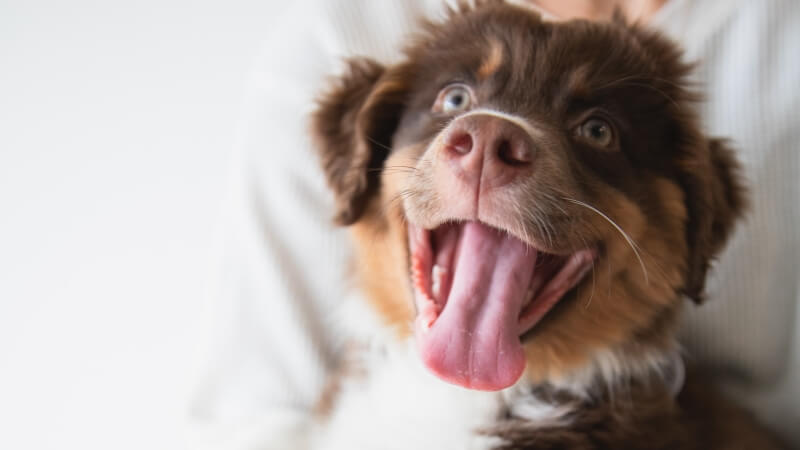
Dog Puzzle Feeder vs Interactive Toys: Which Is Best For Your Pooch?
Choosing the right plaything for your furry friend – be it a dog puzzle feeder or interactive toys – is essential for their mental and

Owning a dog puzzle feeder is an adventure that enriches both your life and your canine companion’s. These clever devices offer mental stimulation and turn mealtime into a playful challenge.
However, no one wants their furry friend’s mealtime adventure marred by the unwelcome guest of mold.
In this comprehensive guide, we’ll embark on a journey to explore the art of mold prevention, ensuring that your puzzle feeder remains a source of delight for both you and your four-legged family member.
Mold, that sneaky foe, often finds its way into our lives when we least expect it. To combat it effectively, you must understand its origins.
Mold is typically fueled by moisture, lingering food residues, and specific environmental conditions. In the world of dog puzzle feeders, this means that dampness and trapped food particles can provide a fertile breeding ground for mold. By identifying these key factors, you’ll be well-equipped to outsmart mold before it sets up shop.
When it comes to moisture, the environment where you store your puzzle feeder plays a significant role.
High humidity levels, condensation, and moisture from improperly sealed storage containers can contribute to mold growth. To address this, we’ll explore strategies to choose the ideal storage spot and ensure that your puzzle feeder remains dry.
Food residues are another factor that can’t be ignored. Even the most diligent pets can leave behind minuscule food particles, which become the perfect feast for mold. We’ll delve into the importance of cleaning your puzzle feeder thoroughly and how to remove all traces of food to prevent mold from taking hold.
Environmental conditions, such as temperature and ventilation, also play a pivotal role in mold prevention. We’ll discuss how these factors can influence the likelihood of mold growth and what steps you can take to mitigate their impact.
The quest for mold prevention begins with your choice of materials and design for your puzzle feeder.
Selecting materials that are naturally mold-resistant is a smart move.
High-quality plastics and stainless steel, for example, are excellent choices because they are less porous and more resistant to mold. These materials also tend to have smoother surfaces, making it harder for mold to take hold. We’ll guide you through the process of selecting a puzzle feeder with these features.
Additionally, the design of your puzzle feeder can impact how easily it can be cleaned and maintained. Opting for a feeder with smooth, accessible surfaces is essential. Such designs leave fewer hiding spots for mold to thrive, ensuring that your cleaning efforts are more effective.
Proper storage is a vital aspect of mold prevention.
Start by selecting an ideal storage location. This should be a dry, well-ventilated area away from direct sunlight. Moisture and darkness are mold’s allies, so choosing the right spot is key. Consider investing in storage containers designed to keep your puzzle feeder safe from environmental threats.
While storage location is crucial, the type of container you use is equally important. Airtight containers made of materials that discourage moisture buildup are excellent choices. We’ll provide tips on selecting the right storage container to complement your mold prevention efforts.
The age-old wisdom of “cleanliness is next to godliness” applies to your puzzle feeder too. Regular cleaning is your most potent weapon against mold.
Creating a cleaning routine doesn’t have to be a chore. Establish a schedule that fits seamlessly into your and your pet’s life. By sticking to a consistent cleaning regimen, you’ll thwart the accumulation of food residues and moisture, reducing the risk of mold growth.
During cleaning, it’s essential to disassemble your puzzle feeder as much as possible to access all nooks and crannies. We’ll provide step-by-step instructions on how to clean each component thoroughly, ensuring that no mold-friendly hiding spots are left unattended.
In addition to regular cleaning, maintenance checks are essential. Periodic inspections allow you to identify any signs of wear, damage, or, heaven forbid, mold growth.
Catching these issues early allows you to address them before they become major headaches. Keep a watchful eye on the environment where your feeder is stored to ensure it remains a mold-unfriendly zone.
In the battle against mold, mold inhibitors are your secret weapon.
Mold inhibitors are substances designed to thwart mold growth on surfaces. They can be especially useful for puzzle feeders with components that are challenging to clean thoroughly. However, always adhere to the manufacturer’s instructions to ensure that they are both effective and safe for your pet.
Before applying any mold inhibitors, it’s essential to understand how they work. We’ll provide insights into the mechanisms behind these substances, giving you a clear understanding of their role in mold prevention.
When applying mold inhibitors, it’s crucial to follow best practices to maximize their effectiveness. We’ll guide you through the process, including tips on where and how to apply these substances safely.
Vigilance is the name of the game when it comes to mold prevention.
Regularly inspect your puzzle feeder for signs of wear, damage, or, heaven forbid, mold growth. Catching issues early allows you to address them before they become major headaches. We’ll provide a checklist of what to look for during your inspections to ensure thorough monitoring.
Environmental factors can change over time, impacting the mold risk for your puzzle feeder. Therefore, it’s crucial to maintain awareness of the conditions where your feeder is stored. We’ll provide guidance on monitoring for changes that could affect mold growth.
In summary, the journey to keeping your dog puzzle feeder mold-free encompasses understanding the causes of mold, making wise choices in materials and design, following best storage practices, regular cleaning and maintenance, judicious use of mold inhibitors, and unwavering vigilance through periodic inspection and monitoring.
With the knowledge and strategies gleaned from this guide, you can rest assured that your pet will enjoy their mealtime challenges in a clean, mold-free environment.
So, take the helm, maintain cleanliness, and witness your furry friend savor a mold-free puzzle-solving feast! Your dedication to their well-being deserves a standing ovation.
FAQ 1: Can I use common household disinfectants to clean my puzzle feeder?
Answer: Yes, you can use common household disinfectants, but it’s essential to choose one that is safe for your pet. Opt for pet-friendly disinfectants available at most pet supply stores to ensure your furry friend’s safety while keeping your puzzle feeder mold-free.
FAQ 2: How often should I replace my puzzle feeder to prevent mold growth?
Answer: While there’s no set time frame for replacement, regularly inspect your puzzle feeder for wear and damage. If you notice cracks, excessive wear, or mold growth that can’t be effectively cleaned, it may be time to consider a replacement to maintain a mold-free environment for your pet.
FAQ 3: What’s the best way to tackle moldy odors from my puzzle feeder?
Answer: To combat unpleasant odors, try a mixture of baking soda and water. Make a paste and gently scrub the affected areas. Rinse thoroughly and dry before use. This natural solution can help eliminate odors without exposing your pet to harmful chemicals.
FAQ 4: Can I store my puzzle feeder outdoors if it’s covered by rain and sunlight?
Answer: While covering your puzzle feeder outdoors can help protect it from direct rain and sunlight, outdoor storage can still expose it to humidity and temperature fluctuations, which can contribute to mold growth. It’s best to store it indoors in a cool, dry place for optimal mold prevention.
FAQ 5: What’s the ideal humidity level for puzzle feeder storage?
Answer: Aim for a humidity level of around 30-50% in the storage area. Using a dehumidifier can help maintain these levels and create an environment less conducive to mold growth. Monitoring humidity levels is an often overlooked aspect of mold prevention.


Choosing the right plaything for your furry friend – be it a dog puzzle feeder or interactive toys – is essential for their mental and

Wondering if a puzzle feeder could revolutionize your pet’s mealtime into an exciting challenge? This unique device promises to engage your furry friend both mentally

For passionate pet enthusiasts, a puzzle feeder is more than just a toy; it’s a critical tool for mental stimulation and dietary control for their

Are you ready to dive deeper into the world of puzzle feeder and embark on a journey to ensure your furry friends remain mentally stimulated?

Choosing the right plaything for your furry friend – be it a dog puzzle feeder or interactive toys – is essential for their mental and

Wondering if a puzzle feeder could revolutionize your pet’s mealtime into an exciting challenge? This unique device promises to engage your furry friend both mentally

For passionate pet enthusiasts, a puzzle feeder is more than just a toy; it’s a critical tool for mental stimulation and dietary control for their

Are you ready to dive deeper into the world of puzzle feeder and embark on a journey to ensure your furry friends remain mentally stimulated?
Copyright © 2024 puppypuzzlefeeder. All Rights Reserved.